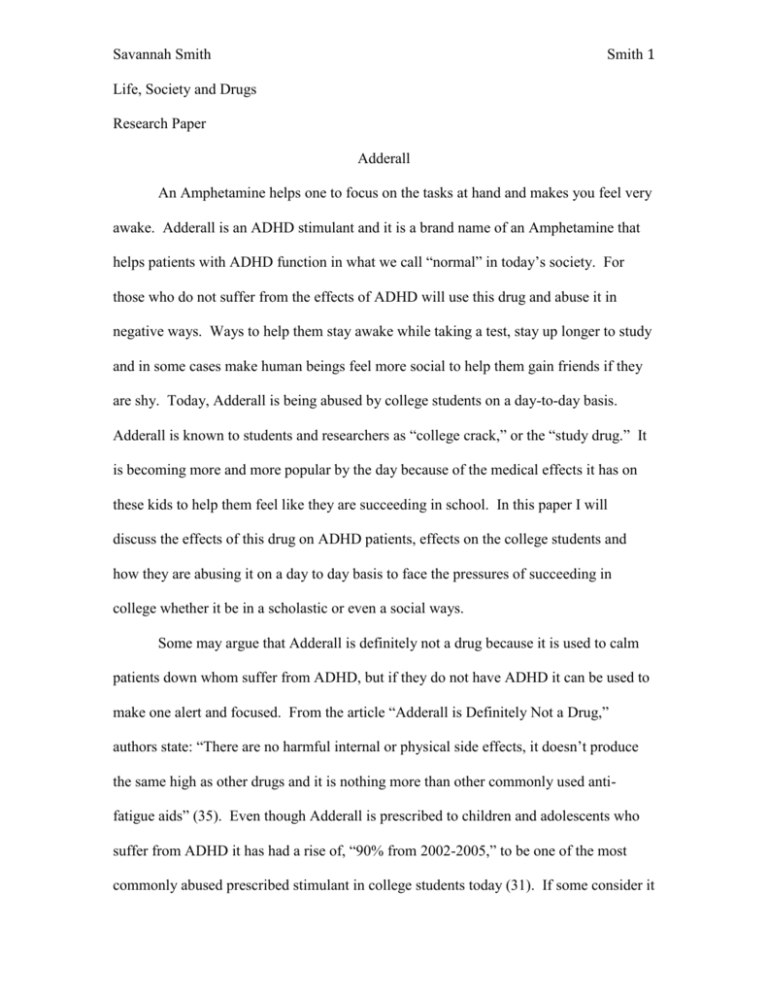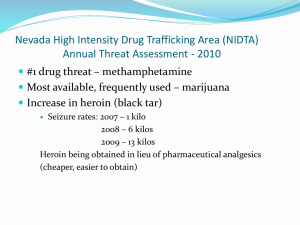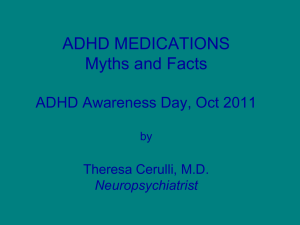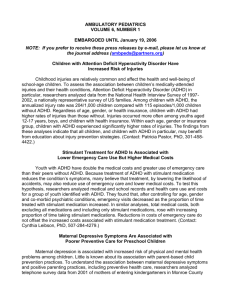Smith 1 Adderall An Amphetamine helps one to focus on the tasks at
advertisement

Smith 1 Savannah Smith Life, Society and Drugs Research Paper Adderall An Amphetamine helps one to focus on the tasks at hand and makes you feel very awake. Adderall is an ADHD stimulant and it is a brand name of an Amphetamine that helps patients with ADHD function in what we call “normal” in today’s society. For those who do not suffer from the effects of ADHD will use this drug and abuse it in negative ways. Ways to help them stay awake while taking a test, stay up longer to study and in some cases make human beings feel more social to help them gain friends if they are shy. Today, Adderall is being abused by college students on a day-to-day basis. Adderall is known to students and researchers as “college crack,” or the “study drug.” It is becoming more and more popular by the day because of the medical effects it has on these kids to help them feel like they are succeeding in school. In this paper I will discuss the effects of this drug on ADHD patients, effects on the college students and how they are abusing it on a day to day basis to face the pressures of succeeding in college whether it be in a scholastic or even a social ways. Some may argue that Adderall is definitely not a drug because it is used to calm patients down whom suffer from ADHD, but if they do not have ADHD it can be used to make one alert and focused. From the article “Adderall is Definitely Not a Drug,” authors state: “There are no harmful internal or physical side effects, it doesn’t produce the same high as other drugs and it is nothing more than other commonly used antifatigue aids” (35). Even though Adderall is prescribed to children and adolescents who suffer from ADHD it has had a rise of, “90% from 2002-2005,” to be one of the most commonly abused prescribed stimulant in college students today (31). If some consider it Smith 2 to not be a drug, why is it being abused? Since about the 1990’s Adderall was introduced to college students as a stimulant drug to help them stay awake during the late night study sessions, finish their research papers and ultimately stay awake during the tests they crammed for. This drug has become a worldwide phenomenon to college students all over, mainly in the Northeast part of the United States. From Desantis’ and Hane’s article a survey was done where, “10,904 students at 119 nationally representative 4-years colleges in the United States. They found that 6.9% of the students surveyed had used an illegal prescription stimulant in their life, with 4.1% using in the past year. Furthermore, they reported that illicit use was highest among 1) white fraternity members; 2) students from the northeastern region of the United States; 3) students from colleges with more competitive admission standards” (32). There have been many more studies that will tell the same thing. College students take this drug because it is the “study drug” known worldwide. From the book “High and Mighty,” Abigail Rasminsky states; “It is like having ten cups of coffee plus a drink that makes you concentrate all in one” (117). Pictured below is a chart of a survey taken in the Northeastern part of the United States that shows statistics of the subjects they picked for this survey (34). DeSantis and Hane Table 1 Interviewee demographic information Demographic category N Gender Male 94 Female 81 Race White/Caucasian 162 Other race/ethnicity 13 Year in school Freshman 33 Sophomore 41 Junior 49 Senior 52 Greek affiliation Smith 3 Fraternity (male) Sorority (female) 63 48 As you can tell from this table there isn’t a majority of a certain race or gender that takes this drug because these college students found this drug one of the most beneficial stimulant drugs to help them succeed in school. Although, the article: “Non-medical use of prescription stimulants among US college students: prevalence and correlates from a national survey” states, that “women are more likely to take this stimulant because it curbs their appetite, making them loose weight” (103). College students lean toward this drug because it show up on a drug test, there are no harmful internal or physical side effects, it doesn’t produce the same “high” as other drugs and it is nothing more than other commonly used anti-fatigue aids (33). If this drug doesn’t show up on drug-tests that must mean it is okay to take right? “Adderall is produced, regulated and prescribed by medical establishments and it is not targeted by law enforcement” (35). When college students realize this information, they start to see it as being “okay” to take. Students will compare it to alcohol because it doesn’t produce the same “sloppy” feeling as alcohol if you were to take it as a party drug (36). This is why college students will argue and say there are no internal or physical side effects because it doesn’t damage you liver, lungs or kidneys like cigarettes and alcohol. It is when researchers start to see a trend not only to take it is the study drug, but now students are taking it at parties and social gatherings because it gives them more energy and makes them more social. They don’t have to drink alcohol in order to become social anymore, all they have to do is pop the pill and they will go from a wallflower to a social butterfly. Smith 4 From the article “Illicit Use of Prescription ADHD Medications on a College Campus: A Multi-Methodological Approach,” the authors will tell you there are in fact academic motives and non-academic motives for students’ reasoning’s behind taking this stimulant drug. As seen below is another table from another study that will help us trying to understand students’ motives for taking this drug. It includes first time user statistics, academic motives and non-academic motives (318). TABLE 1. Illicit Use of Prescription ADHD Medications in Various Demographic Subgroups Using Demographic n% Not using n% Overall 585 34 1,148 66 Sex*** Male 278 39 430 61 Female 266 30 629 70 Race* White/Caucasian 547 35 1,032 65 Other race/ethnicity34 25 101 75 Year in school*** Freshman 101 18 473 82 Sophomore 127 31 288 69 Junior 144 49 150 51 Senior 137 55 112 45 Greek status*** No 228 23 747 77 Yes 357 48 389 52 Note. ADHD = attention deficit hyperactivity disorder. *p < .05. **p < .01. ***p < .001. TABLE 2. Reasons for Illegal Use of Prescription ADHD Medications (N = 585) Reason for use n % To stay awake to study 420 72 To concentrate on your work 389 66 To help memorize 213 36 To stay awake and have fun 127 22 To make work more interesting 70 12 For the high (the good feeling) 39 7 To suppress your appetite 32 5 To self-medicate ADHD 22 12 Other 10 2 Note. ADHD = attention deficit hyperactivity disorder. Smith 5 The table above shows us once again there is no predominant race, gender or ethnicity that sparks the use of this stimulant drug. We can also tell that from the study above more college students are taking this stimulant to succeed in school, study longer and more and to also become more social because they like the way they feel. The article titled: “Prescription Stimulant Expectancies in Recreational and Medical Users: Results from a Preliminary Expectancy Questionnaire,” authors Looby and Earleywine point out that, “the people that take it for a medical reason will in fact have more of a positive outcome because they are taking it for a medical problem compared to the recreational users who are taking it for the main purpose to stay focused and take it during finals” (1580). Many people claim that Adderall has absolutely no side effects and does nothing to damage your body internally and mentally. How can this be? In fact, the people that think this are totally wrong because this is a stimulant drug, which means there are amphetamines in it, which alter your brain in many ways. “Adderall puts your heart at risk, which means that by abusing them you are essentially putting your life in your hands.” “Your heart rate goes up, leads to digestive problems, feelings of euphoria, emotional repercussions and depression” (117). These are some short-term and long-term effects placed on recreational users that only take this stimulant a few times. Overall, the effects Adderall has on college students, also known as the recreational users, can be life threatening. It can at the time make you feel as if you are doing absolutely nothing wrong to your body. Although it has been proven that there are in fact both short-term and long-term effects the body goes through. Adderall is a stimulant drug that is used to treat adolescents that suffer from ADHD, it is not to be used as a random stimulant to help you to try to cram for a test or be able to talk to more people at Smith 6 parties. This stimulant drug is becoming more and more popular worldwide with college students. After reviewing the facts presented please don’t let this number continue to grow. A drug is a drug no matter how you view it. Drugs like Adderall may seem harmless to the frequent users whom suffer from ADHD, but to the recreational users it can ultimately be harmful and alter your body dramatically. Do not continue to let the number of recreational users of this drug grow, it will only hurt you and your loved ones in the long run. Smith 7 Works Cited Desantis, Alan D., and Audrey Curtis Hane. "''Adderall is Definitely Not a Drug'': Justifications for the Illegal Use of ADHD Stimulants." Substance Use & Misuse 45.1/2 (2010): 31-46. Academic Search Premier. EBSCO. Web. 16 Oct. 2011. DeSantis, Alan D., Elizabeth M. Webb, and Seth M. Noar. "Illicit Use of Prescription ADHD Medications on a College Campus: A Multimethodological Approach." Journal of American College Health 57.3 (2008): 315-324. Academic Search Premier. EBSCO. Web. 16 Oct. 2011. Henry Wechsler, et al. "Non-medical use of prescription stimulants among US college students: prevalence and correlates from a national survey." Addiction 100.1 (2005): 96-106. Academic Search Premier. EBSCO. Web. 16 Oct. 2011. Looby, Alison, and Mitch Earleywine. "Prescription Stimulant Expectancies in Recreational and Medical Users: Results from a Preliminary Expectancy Questionnaire." Substance Use & Misuse 44.11 (2009): 1578-1591. Academic Search Premier. EBSCO. Web. 16 Oct. 2011 Rasminsky, Abigail. "HIGH AND MIGHTY." Dance Spirit 12.7 (2008): 116-118. Academic Search Premier. EBSCO. Web. 16 Oct. 2011






